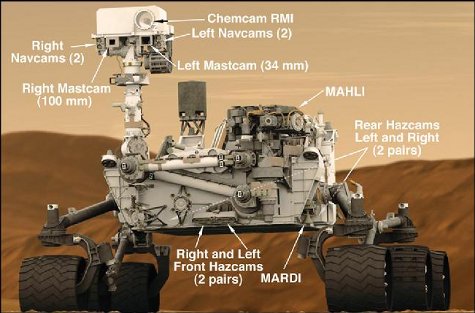Creation Corner
Curiosity, machine and motive

Hours after this post goes public, another roving robot, named Curiosity, will (one hopes) land on Mars. The builders of Curiosity choose a good name for their rover, with its seventeen cameras and on-board laboratory. They probably don’t realize that curiosity, both the machine and the motive, come from God. The machine might not seem to, but it is an indirect product. Man, with his basic curiosity built in, is the direct product.
Curiosity takes off
Curiosity, centerpiece of the Mars Science Lab mission, took off on November 26, 2011, atop an Atlas V rocket. It is due to land at 5:31 am UTC. Its launch and control authorities (NASA and Caltech’s Jet Propulsion Laboratory) expect “seven minutes of terror” before Curiosity lands, either intact or not. The reason: Curiosity will have the most complex automatic landing that any spacecraft, especially a robot spacecraft, has tried to make.
The robot probes (standing and roving) that have landed on Mars before, have landed either by parachute or by rocket. Curiosity must use both. It is too heavy to land by parachute alone. But Curiosity carries some of the most sensitive instruments that any rover has ever carried. Too sensitive for the cloud of dust that rockets would raise.
So the supersonic parachute will slow Curiosity down to 200 miles per hour. Then a special crane will drop from the parachute rig and use its rockets to set Curiosity on the ground, at the end of a tether. Once Curiosity’s six wheels are on the ground, the tether will let go, and the crane will bounce away and crash.
The problem: Mars is about seven light-minutes away from earth. So no one can pilot Curiosity to a landing. Curiosity, and its “sky crane,” must follow the strict instructions that they carry with them. The ones who wrote those instructions, assumed that the lay of the land, the winds, and the thickness of the air would be a certain way. If any of these is not as the authors supposed, the rover will crash. And the JPL crew won’t know until seven minutes later.
No accident
Any deep space mission can only come about from intelligent design, planning, and building. No one can seriously imagine that a machine as complex as Curiosity could assemble itself from junk. (And certainly not from sand, ore, natural rubber, flax, and the other raw materials for making it.) More than that, Curiosity’s tires have a curious tread pattern. Its makers installed a three-letter abbreviation in the tread:
·— ·–· ·-··
[ezadsense midpost]
That is international code for the letters J, P, and L, the letter word for the Jet Propulsion Laboratory. Samuel F. B. Morse invented the first version of that code, of course. Morse is famous for the first message he ever sent over his new invention:
What God hath wrought!
Morse understood what many today forget: anything man builds, God made possible, because God “built” man. Somebody built man. As complex a machine as Curiosity is, man is a thousand times more complex. And unlike Curiosity, man can give instruction as well as take it, and can act beyond instruction if he must.
A model of behavior
The instructions that Curiosity carries, that (one hopes) will lead it to land intact, are a model for animal behavior. If Curiosity can land safely, that is only because its builders have given it not only physical stamina but also a behavior to follow. Animal behavior is, at heart, programming. These “programs” sit in an animal’s brain (exactly where and how they work, no one knows yet). Did those instructions write themselves? No. (If Curiosity could write its own instructions, no one would be taking about “seven minutes of terror”!) So who wrote them? God did.
Finding life
Will Curiosity find life on Mars? No one knows. NASA is the only launch authority to place probes on Mars. For more than thirty-five years, NASA has looked for life on Mars. It hasn’t found it yet, but it still might.
Would life on Mars invalidate Genesis chapter 1? No. In fact, some probe like Curiosity will find life on Mars. Life that came from Earth, in the same disaster that caused a Global Flood. Walter T. Brown, in In the Beginning, makes the case. The key clue: methane, which bacteria, especially gut flora, produce. Furthermore, the methane on Mars is not uniform; it comes from small pockets near the surface. One of them: the Gale crater, where Curiosity will touch down.
[amazon_carousel widget_type=”ASINList” width=”500″ height=”250″ title=”” market_place=”US” shuffle_products=”True” show_border=”False” asin=”1878026097, 0890515077, 0310234697, 0875523382, 0890511586, B002RBHDFK, 0949906689, 0890513600, 089051416X, 0890515050″ /]
[ezadsense leadout]
Terry A. Hurlbut has been a student of politics, philosophy, and science for more than 35 years. He is a graduate of Yale College and has served as a physician-level laboratory administrator in a 250-bed community hospital. He also is a serious student of the Bible, is conversant in its two primary original languages, and has followed the creation-science movement closely since 1993.
-

 Civilization4 days ago
Civilization4 days agoDC Pipe Bomb Arrest Raises Questions About Christopher’s Wray’s FBI
-

 Civilization5 days ago
Civilization5 days agoThe Legal Logic Behind U.S. Operations Against Narco-Terrorist Networks
-

 Executive5 days ago
Executive5 days agoNewsom’s ‘National Model’ for Homeless Wracked by Fraud
-

 Executive4 days ago
Executive4 days agoWhen You’re in a Hole, Stop Digging
-

 Education3 days ago
Education3 days agoWaste of the Day: Taxpayers Subsidize Football Coach Severance
-

 Executive2 days ago
Executive2 days agoWaste of the Day: Obamacare Failed Test, Approved Fraudulent Subsidies
-

 Civilization3 days ago
Civilization3 days agoPence Calls on Trump To Fire RFK Jr Over Abortion Drug
-

 Executive4 days ago
Executive4 days agoWaste of the Day: Feds Pay Nonprofits That Sue the Government
















[…] ~ "Curiosity, machine and motive" ~ GA_googleFillSlot("TaurusArmed-300P"); "A roving robot named Curiosity will shortly land on Mars. Both the machine and the motive behind it (and its name) are products of God" Curiosity, machine and motive – Conservative News and Views […]
[…] Reprinted from Conservative News and Views This entry was posted in News and tagged astronomy, creation, evidence, scientific theory by Terry Hurlbut. Bookmark the permalink. […]
“some probe like Curiosity will find life on Mars.”
Well, probably not. Traces of previous life is definitely possible, though.
“Life that came from Earth”
Um. What will you say if life is discovered on Mars and proves to be completely different from Earth life? What if, say, it uses a totally different heredity mechanism that doesn’t even vaguely resemble DNA?
The trouble, from your POV, is this: we already have seen forms of life on earth that can thrive in all sorts of weird environments. Even a live volcano crater is not too hot. Find out, if you’re curious, what an “extremophile” is.
Actually, Fergus Mason’s question is a fair one. All known organisms use DNA with the exception of certain viruses which use RNA instead. So what are you going to say if the rover discovers a new life form that doesn’t use DNA or something similar?
I’m not worried about that. As I’ve said in direct response, any form of life departing that radically from the norm in heredity would probably depart in many other ways. Including the metabolic process that produces methane.
What “norm”? All we can say about DNA/RNA-based heredity is that it’s the norm on this planet. For all we know there could be millions of cvilisations out there who’d regard it as weird beyond belief.
You’re evading the question, Terry. What would you say if the rover discovered something that did not support your preconceptions about how nature works?
I’m not evading the question. I am refusing to answer, on the grounds that it is an absurd hypothetical for which neither you nor, I daresay, any of your likely sources have laid so much as one brick of foundation.
In any court of law, no witness needs to answer a question for which the questioner has laid insufficient foundation. You hear that objection all the time. And others, like “hearsay” and “incompetent, irrelevant, and immaterial.”
Tell you what, neighbor. Come back when you have grounds to suspect that some kind of self-replicating chemical machine exists on Mars (but nothing like it on earth) that does not use nucleic acids in any way, shape or form.
That’s a tall order. And of course I set a high bar.
“on the grounds that it is an absurd hypothetical”
Why is it an absurd hypothetical, Terry? There are 400 BILLION galaxies out there with an average of 100 billion stars in each one. At least 10% of those stars, and maybe half of them, have planets. Do you really think life only arose on this one?
Ah, yes, the numbers game. Guess what? Those numbers are still too small, by uncountable orders of magnitude. There shouldn’t even be life on this planet! But God in His Wisdom set it up that way. (Otherwise, we wouldn’t be around to talk about it.)
And those numbers are irrelevant anyway. You’re trying to maintain that life arose on Mars. Even by atheistic naturalistic (that is, abiogenetic) presumptions, conditions on Mars are somewhat less than favorable. And when those same people say, “This is now, but that was then” (meaning that conditions once were favorable), they violate the central dogma of the general theory of evolution, which is: uniformitarianism.
And uniformitarianism says that all conditions present today, always have been present, and all processes that work today, have always worked, and at the same rate, since time immemorial.
I know what extremophiles are and they’re fascinating. Even among more conventional animals there are some pretty weird things on Earth: link to helium.com
However extremophiles and giant tube worms use the same basic biology as all other known life, which is what science predicts anyway. What I was really asking is, what if we find something different? An organism that used some completely different heredity mechanism, totally unlike DNA or RNA, for example?
Gravity is a bit of an obstacle to Mars being seeded with life from Earth, by the way, but the reverse is certainly possible. In any case the landing of Curiosity is very exciting and I’m following it closely. It’s nice to see that the USA hasn’t completely abandoned scientific adventure.
Your hypothetical is virtually unimaginable. Besides, life making such a radical departure in heredity, would make an equally radical departure in metabolism. Result: no methane.
As to gravity as an obstacle, Walt Brown has definitely shown that the violent events of the Global Flood handily overcame that obstacle.
To your final point: as I type this, we now know that Curiosity has landed with its radio and at least some of its cameras intact (because Curiosity had to use them to send back some pictures). NASA has no reason to think that anything is “broken.” Of course, the only way to find out whether anything works is to try it out. That will take a month.
Actually I can imagine several ways in which life could inherit without DNA or RNA. As I said I am sure that any Martian life would be carbon based – the only real alternative is silicon, and the given conditions on Mars the bar for that is a lot higher than for organic life – so I don’t see why methane (which also has many non-biogenic origins, of course) would be ruled out.
It does look as if the rover has landed relatively intact; it’s even communicating on Twitter. I’m pretty excited about its potential, especially considering how massively the previous rovers outperformed their design specs. Curiosity is far more capable than them and carries a much larger science package. As well as looking for evidence of life it can tell us a lot about Martian geology, too.
As Walt Brown’s cosmic splatter hypothesis has more holes than a box of teabags I won’t bother considering it.
We’ll see where the evidence leads, of course. For my part, I am relieved that a billion-dollar investment over many years (going back to the Bush administration) did not go to waste. And I remember, as I assume you do, that Spirit and Opportunity lasted many years, when they were projected to last for ninety Martian days! Opportunity is still functioning. (Spirit died a year or so ago, after being stuck in the sand for another year.)
We will indeed. I’m willing to follow it where it goes, and I hope you are too. NASA have made a great achievement in getting a machine that size to another world and I’m proud that my adopted country is one of the nations that contributed to the science package. Yes, I remember Spirit and Opportunity, which is why I mentioned them outperforming design specs. Anyway, nice to see that we can agree on how exciting it is.
The entire mission was developed and executed using government money. Some of the equipment was directly researched and developed by government institutions.
The private sector has never funded and launched an interplanetary research mission.
Yay for Ayn Rand.
That’s because the government grabs so much that it leaves nothing over for the private sector to take anything like that on. Nor would they think they could compete with the all-powerful 800-pound gorilla government.
In 2008 NASA’s budget of just under $18bn was about 50% more than total donations to the Southern Baptist Convention. The Curiosity mission cost $2.5bn. There’s plenty money floating around the USA for anyone who wants to explore the solar system. The Baptists could put four rovers a year on Mars if they wanted to. I shudder to think how many planets the catholic church could explore, but in Germany alone they spend €45bn a year subsidising Caritasverband, and who knows how much on communion wine, biscuits and dresses.
Income from “Megachurches” alone (not complete religious donations) total $9bln *every year*. The LDS has reserves of over $30bln
As religious organisations, they are *tax exempt*.